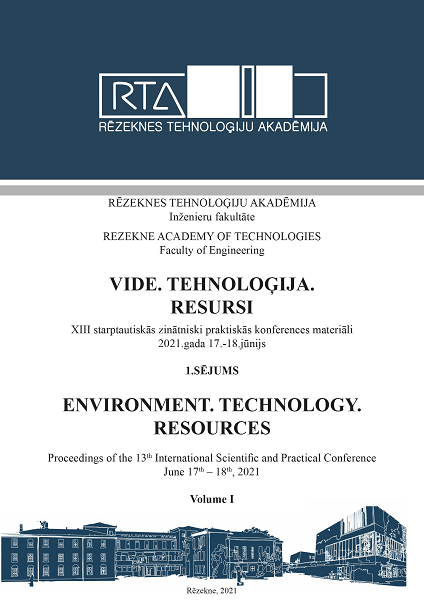PRIMARY ASSESSMENT OF THE DEGREE OF TORREFACTION OF BIOMASS AGRICULTURAL CROPS
DOI:
https://doi.org/10.17770/etr2021vol1.6597Keywords:
biomass, torrefaction, thermal treatment, energy intensity biofuels, thermal decomposition, thermogravimetric investigationAbstract
Biomass energy is an important component in the overall structure of renewable energy and has the greatest potential for increasing volumes. However, the peculiarities of the properties of agro-industrial residues are a significant disadvantage of their widespread use. The process of torrefaction allows to bring the characteristics of biofuel as close as possible to thermal coal. Different degree of heat treatment of biomass leads to a product with different heating value. Therefore, it is important to know the optimal mode of torrefaction, which will provide the best energy parameters of biofuels.
Researches of torrefaction were carried out on the basis of educational and scientific laboratory "DAK GPS" of the State Agrarian and Engineering University in Podilia. The kinetics of the relative mass of different types of biomass at different processing temperatures was considered. The dependence of the degree of torrefaction on the heat treatment temperature is revealed. As shown by studies for most biomaterials of plant origin, we can distinguish the beginning of intensive transformation and its end, after which there is a sharp slowdown in weight loss, and, accordingly, and the energy density of the samples.
Downloads
References
J. Arcate, “New process for torrefied wood manufacturing”. Bioenergy update. vol. 2, 2000.
A. Knapczyk, S. Francik and M. Jewiarz, “Robust optimization in production engineering-methods and application”. E3S Web of Conferences, 2019, pp.132. https://doi.org/10.1051/e3sconf/2019
K. Mudryk, M. Wróbel and M. Jewiarz, “Innovative Production Technology of High Quality Pellets for Power Plants”. Renewable Energy Sources: Engineering, Technology, Innovation. Cham, Switzerland: Springer. 2018, pp. 701–712, https://doi.org/10.1007/978-3-319-72371-6_69
B. Arias, C. Pevida and J. Fermoso, Eds., “Influence of torrefaction on the grindability and reactivity of woody biomass”, Fuel Processing Technology, 89, 2008, pp. 169-175.
T.G. Bridgeman, J.M. Jones and P-T. Williams, “Torrefaction of reed canary grass, wheat straw and willow to enhance solid fuel qualities and combustion properties”, Fuel 87, 2008, pp. 844-856.
P.C.A. Bergman and J.H.A. Kiel, “Torrefaction for biomass upgrading”, Published at 14 th European Biomass Conference and Exhibition, Paris, France, ECNRX-05-180, 2005.
P.A. Mar'yandyshev, E.I. Popova, A.A. CHernov and V.K. Lyubov, “Izotermicheskoe issledovanie drevesnogo topliva i ego organicheskih koponentov” (Isothermal study of wood fuel and its organic components). Vestnik Cherepoveckogo gosudarstvennogo universiteta, № 2 (71), 2016, pp. 15-18.
Z.B. Jankovich and M.M. Jankovich “Pyrolysis of pine and beech woodsamples under isothermal experimental conditions”. The determination of kinetic Cellulose Chemistry and Technology, 2013, Vol.47, pp. 681-697
A. Knapczyk and S. Francik, “Analysis of research trends in the fieldof mechanical engineering”. Tehnologija. Resursi - Environment, Technology, Resources, Vol. 2, 2019, https://doi.org/10.17770/etr2019vol2.4170
S. Yermakov, T. Hutsol and S. Slobodian, Eds., “Possibility of using automation tools for planting of the energy willow cuttings”. Renewable Energy Sources: Engineering, Technology, Innovation. 2018. pp. 419-429.
S. Yermakov, K. Mudryk and T. Hutsol, Eds., “The analysis of stochastic processes in unloadingthe energywillow cuttings from the hopper”. Environment. Technology. Resources. Rezekne, Latvia. Proceedings of the 12th International Scientific and Practical Conference. Vol. III. 2019. pp. 249-252, https://doi:10.17770/etr2019vol3.4159.
M. Korchak, S. Yermakov and V. Maisus, Eds., “Problems of field contamination when growing energy corn as monoculture”. E3S Web of Conferences. Krynica, Poland. 6th International Conference – Renewable Energy Sources. Vol.154, 2020.
V. Ivanyshyn, S. Yermakov and T. Ishchenko, Eds., “Calculation algorithm for the dynamic coefficient of vibro-viscosity and other properties of energy willow cuttings movement in terms of their unloading from the tanker”. Proceedings of 6 th International Conference – Renewable Energy Sources, vol. 154, E3S Web of Conferences. 2020. pp. 04005, https://doi:10.1051/e3sconf/202015404005.
S. Yermakov, T. Hutsol, O. Ovcharuk and I. Kolosiuk “Mathematic simulation of cutting unloading from the bunker”. Independent journal of management & amp; production (IJM&P). Vol. 10, No. 7, 2019. pp. 758-777.
T. Hutsol, S. Yermakov and Ju. Firman, Eds., “Analysis of technical solutions of planting machines, which can be used in planting energy willow”. Renewable Energy Sources: Engineering, Technology, Innovation. 2018. pp. 99-111.
A. Tryhuba, T. Hutsol and S. Glowacki, Eds. “Forecasting Quantitative Risk Indicators of Investors in Projects of Biohydrogen Production from Agricultural Raw Materials”. Processes 2021, 9, pp/ 258. https://doi.org/10.3390/pr9020258
A. Tryhuba, T. Hutsol and I. Tryhuba, Eds. “Risk Assessment of Investments in Projects of Production of Raw Materials for Bioethanol”. Processes. 2021; 9(1):12, https://doi.org/10.3390/pr9010012
V.M. Zajchenko, V.V. Kosov and V.A. Sinel'shchikov, “Torrefikaciya — sposob uluchsheniya potrebitel'skih harakteristik granulirovannogo topliva iz biomassy”. (Torrefaction is a way to improve the consumer characteristics of pelleted biomass fuel.) Energotekhnologii i resursosberezhenie (Energy technologies and resource conservation). 2012. № 5. pp. 37-41.
V.K. Lubov, E.I. Popova and K.S. Bolotova, Eds., “A study of wood torrefaction”. Bulletin of the Cherepovets State University, 2017, no. 3 (78), pp. 38-45.
P.A. Mar'yandyshev, A.A. Chernov and M.K. Eseev, Eds., “Issledovanie processa izotermicheskogo razlozheniya drevesiny”, Himiya tverdogo topliva. №6, 2016. pp. 51–59.


